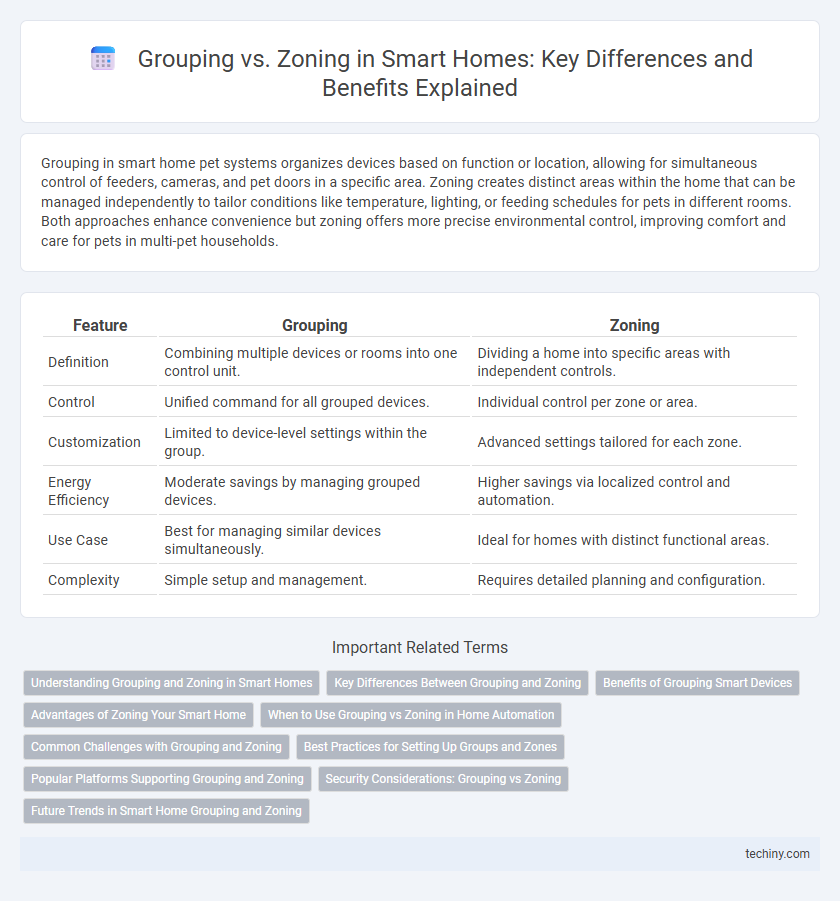Grouping in smart home pet systems organizes devices based on function or location, allowing for simultaneous control of feeders, cameras, and pet doors in a specific area. Zoning creates distinct areas within the home that can be managed independently to tailor conditions like temperature, lighting, or feeding schedules for pets in different rooms. Both approaches enhance convenience but zoning offers more precise environmental control, improving comfort and care for pets in multi-pet households.
Table of Comparison
| Feature | Grouping | Zoning |
|---|---|---|
| Definition | Combining multiple devices or rooms into one control unit. | Dividing a home into specific areas with independent controls. |
| Control | Unified command for all grouped devices. | Individual control per zone or area. |
| Customization | Limited to device-level settings within the group. | Advanced settings tailored for each zone. |
| Energy Efficiency | Moderate savings by managing grouped devices. | Higher savings via localized control and automation. |
| Use Case | Best for managing similar devices simultaneously. | Ideal for homes with distinct functional areas. |
| Complexity | Simple setup and management. | Requires detailed planning and configuration. |
Understanding Grouping and Zoning in Smart Homes
Grouping in smart homes involves organizing devices based on function or location, allowing coordinated control of multiple items simultaneously, such as all lights in a living room. Zoning refers to dividing the home into distinct areas with tailored automation rules, enhancing energy efficiency and personalized comfort by managing HVAC, lighting, and security per zone. Understanding these concepts enables optimized automation, improved device management, and enhanced user experience in smart home systems.
Key Differences Between Grouping and Zoning
Grouping clusters smart home devices based on function or location, enabling simultaneous control, while zoning divides a home into specific areas for targeted automation and environmental settings. Grouping simplifies device management by creating logical sets, whereas zoning optimizes energy use and comfort through area-specific adjustments. The key difference lies in grouping's focus on collective device operation versus zoning's emphasis on spatial customization.
Benefits of Grouping Smart Devices
Grouping smart devices streamlines control by allowing multiple devices to be managed simultaneously through a single command, enhancing convenience and user experience. This method improves energy efficiency by enabling synchronized operation of lighting, heating, and security systems based on user preferences or routines. Grouping also simplifies automation setups, reducing complexity and increasing the effectiveness of smart home ecosystems.
Advantages of Zoning Your Smart Home
Zoning your smart home enables precise control of lighting, climate, and security tailored to specific areas, enhancing energy efficiency and comfort. It reduces energy consumption by targeting only occupied zones, leading to significant cost savings on utility bills. Zoning also improves device management and automation, allowing for personalized settings that adapt to users' routines in each distinct space.
When to Use Grouping vs Zoning in Home Automation
Grouping in home automation is ideal for controlling multiple devices simultaneously within a single room or area, such as turning off all lights in the living room with one command. Zoning is better suited for dividing a home into separate sections based on function or location, allowing tailored automation scenarios like heating only the upstairs bedrooms during nighttime. Employ grouping for convenience in localized control and zoning for energy efficiency and customized environmental management across different parts of the house.
Common Challenges with Grouping and Zoning
Grouping and zoning in smart home systems often face challenges such as device compatibility, inconsistent communication protocols, and complex setup processes. Users frequently struggle with managing overlapping zones that lead to automation conflicts and inefficient energy use. Proper calibration and centralized control interfaces are essential to overcome these issues and ensure seamless operation.
Best Practices for Setting Up Groups and Zones
Grouping devices in a smart home involves organizing similar devices based on function or location, while zoning divides the home into distinct areas for tailored automation. Best practices for setting up groups and zones include clearly defining boundaries to avoid overlap, assigning devices to zones that reflect actual usage patterns, and optimizing control through centralized management platforms. Prioritizing consistency in naming conventions and considering user behavior enhances efficiency and responsiveness in smart home automation.
Popular Platforms Supporting Grouping and Zoning
Popular smart home platforms like Samsung SmartThings and Apple HomeKit offer robust support for both grouping and zoning, enabling efficient device management and automation. Grouping allows users to control devices collectively, while zoning organizes devices based on physical locations or functions for streamlined automation. Amazon Alexa also supports grouping through device groups and routines, enhancing user convenience by simplifying multi-device control within defined zones.
Security Considerations: Grouping vs Zoning
Grouping devices in a smart home allows for collective control but may pose security risks if one device is compromised, potentially affecting the entire group. Zoning enhances security by isolating devices within specific areas, limiting the impact of breaches to localized zones. Implementing zoning strategies reduces vulnerability exposure and strengthens access control across different home sections.
Future Trends in Smart Home Grouping and Zoning
Future trends in smart home grouping and zoning emphasize enhanced AI integration for dynamic adaptation to user preferences, optimizing energy efficiency and comfort. Advanced sensors and machine learning algorithms will enable more granular control, automatically customizing environments based on activity, occupancy, and time of day. Interconnected ecosystems will support seamless communication between devices across zones, creating intelligent, responsive living spaces that evolve with resident needs.
Grouping vs Zoning Infographic

 techiny.com
techiny.com